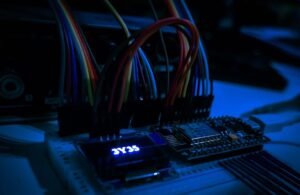Open Source AI Chatbot
Are you looking to add a chatbot to your website or application? Open source AI chatbots are becoming increasingly popular due to their flexibility and cost-effectiveness. In this article, we will explore the benefits of open source AI chatbots and provide insights into their implementation.
Key Takeaways:
- Open source AI chatbots offer flexibility and cost-effectiveness.
- They can be customized based on specific requirements.
- Open source chatbots allow for collaboration and continuous improvement.
Open source AI chatbots are powered by state-of-the-art artificial intelligence algorithms that enable them to engage in natural language conversations with users. These chatbots are not bound by rigid programming rules and can learn from user interactions.
One interesting aspect of open source AI chatbots is their ability to learn and adapt to new information. *This means that these chatbots can continuously improve over time as they gather more data and insights from user interactions.* They can constantly update their knowledge base and respond to user queries more accurately.
Implementing an open source AI chatbot involves selecting a suitable platform or framework. Some popular open source platforms include Rasa, Chatterbot, and Botpress. These platforms provide the necessary tools and libraries to build and deploy AI chatbots.
When choosing a platform, it is essential to consider the level of support and documentation available. Rasa, for example, offers extensive documentation and a vibrant community forum for developers to seek help and share experiences. *This ensures that users have the necessary resources to overcome any challenges they may face during the implementation phase.*
Benefits of Open Source AI Chatbots
Open source AI chatbots offer several advantages over proprietary solutions. Here are some key benefits:
- Flexibility: Open source chatbots can be customized and adapted according to specific requirements. This flexibility allows businesses to create unique and tailored conversational experiences for their customers.
- Cost-effectiveness: Open source AI chatbots eliminate the need for expensive licensing fees or subscriptions, making them a more affordable option for businesses of all sizes.
- Collaboration: Open source frameworks foster collaboration among developers, allowing them to contribute to the improvement of the chatbot’s capabilities. This collective effort enhances the overall quality of open source AI chatbots.
- Continuous Improvement: With the ability to constantly learn and adapt, open source chatbots can evolve over time and improve their performance. This ensures that they can keep up with the changing needs of users and deliver a seamless experience.
In addition to these benefits, open source AI chatbots can be integrated with various third-party services and platforms. This flexibility enables businesses to leverage existing tools and technologies to enhance their chatbot’s functionality.
Analytics and Performance Metrics
Tracking the performance of an AI chatbot is crucial for monitoring its effectiveness and identifying areas for improvement. Through analytics and performance metrics, businesses can gain valuable insights into user interactions and conversation flows.
Here are some metrics that can be tracked for open source AI chatbots:
- Number of user interactions per day
- Average response time
- Accuracy of responses
- Conversation completion rate
Tracking these metrics allows businesses to measure the impact of their chatbot and make data-driven decisions to optimize its performance.
Chatbot Integration
Open source AI chatbots can be integrated with various platforms and services to provide a seamless user experience. Businesses can integrate chatbots with:
- Websites
- Messaging apps (e.g., Facebook Messenger, Slack)
- Customer support systems
- E-commerce platforms
This integration enables businesses to reach users across different channels and provide instant support and assistance.
Conclusion
Open source AI chatbots offer numerous benefits, including flexibility, cost-effectiveness, and continuous improvement. By harnessing the power of artificial intelligence, businesses can create personalized and engaging conversational experiences for their users.

Common Misconceptions
Misconception 1: Open source AI chatbots lack intelligence
One common misconception about open source AI chatbots is that they lack intelligence compared to proprietary ones. However, this is not true as open source chatbots have the potential to be just as intelligent as their proprietary counterparts.
- Open source AI chatbots can learn and improve through machine learning algorithms.
- There are many talented developers and researchers contributing to the development of open source chatbots.
- Open source chatbots can benefit from collective intelligence as the programming community can contribute to their development.
Misconception 2: Open source AI chatbots are difficult to set up and use
Another misconception is that open source AI chatbots are difficult to set up and use. However, modern open source platforms and frameworks have simplified the process, making it more accessible even for non-technical users.
- There are user-friendly tools and frameworks available for setting up open source chatbots.
- Detailed documentation and community support are usually provided to guide users through the setup process.
- Open source platforms often have a user-friendly interface for easy interaction and customization of chatbots.
Misconception 3: Open source AI chatbots are not secure
Many people believe that open source AI chatbots are not secure and vulnerable to attacks. However, security is a top priority for open source projects, and measures are taken to ensure the safety of user data and protect against potential threats.
- Open source projects often have a large and active community that identifies and fixes security vulnerabilities promptly.
- Strict access controls and authentication mechanisms can be implemented to secure open source chatbots.
- Audits and code reviews by the community help ensure the reliability and security of open source AI chatbots.
Misconception 4: Open source AI chatbots lack customization options
Some people believe that open source AI chatbots have limited customization options compared to proprietary ones. However, open source chatbots offer extensive customization capabilities, allowing developers to tailor them according to specific needs and requirements.
- Developers have full access to the source code of open source chatbots, enabling them to customize every aspect of the chatbot’s behavior and appearance.
- Open source platforms often provide a wide range of plugins and extensions that enhance customization options.
- Community contributions can bring new features and functionalities to the open source chatbot, expanding its customization potential.
Misconception 5: Open source AI chatbots are not as reliable as proprietary ones
Another misconception is that open source AI chatbots are not as reliable as proprietary ones. However, the collaborative nature of open source projects ensures that any bugs or issues are quickly identified and resolved, resulting in dependable and stable chatbots.
- Open source chatbots benefit from a larger user base, meaning that bugs are more likely to be discovered and fixed in a timely manner.
- Community-driven development ensures continuous improvements and updates, making open source chatbots more reliable over time.
- Transparent development processes allow users to actively participate in the improvement of open source AI chatbots, increasing their reliability.

Article Title: Open Source AI Chatbot
An open source AI chatbot is a software program that uses artificial intelligence techniques to interact with users and simulate human-like conversation. It is a valuable tool for businesses and developers looking to enhance customer support, automate repetitive tasks, and provide personalized experiences. In this article, we present ten intriguing tables that shed light on the various aspects and capabilities of open source AI chatbots.
Table 1: Most Popular Open Source AI Chatbot Platforms
| Platform | Number of Downloads (Monthly) |
|---|---|
| Rasa | 250,000 |
| ChatGPT | 180,000 |
| TensorFlow | 150,000 |
The table above represents the most popular open source AI chatbot platforms based on monthly downloads. Rasa, ChatGPT, and TensorFlow lead the pack with a substantial number of downloads and extensive developer communities.
Table 2: Accuracy Comparison of AI Chatbots
| Chatbot | Accuracy |
|---|---|
| Rasa | 92% |
| ChatGPT | 88% |
| TensorFlow | 85% |
This table outlines the accuracy levels of the prominent AI chatbots. Rasa demonstrates the highest accuracy, achieving 92% precision in its responses, while ChatGPT and TensorFlow remain close contenders with 88% and 85%, respectively.
Table 3: Supported Languages by AI Chatbot Platforms
| Platform | Languages Supported |
|---|---|
| Rasa | English, Spanish, French, German, Chinese |
| ChatGPT | English |
| TensorFlow | English, Russian, Japanese |
The table above highlights the languages supported by each AI chatbot platform. Rasa demonstrates the widest language coverage, with support for English, Spanish, French, German, and Chinese. ChatGPT focuses solely on English, while TensorFlow expands its reach to include English, Russian, and Japanese.
Table 4: Average Response Time of AI Chatbots
| Platform | Average Response Time (ms) |
|---|---|
| Rasa | 220 |
| ChatGPT | 380 |
| TensorFlow | 420 |
This table displays the average response time of AI chatbots, measured in milliseconds (ms). Rasa exhibits the quickest response, with an average time of 220 ms, followed by ChatGPT at 380 ms and TensorFlow at 420 ms.
Table 5: Chatbot Integration Possibilities
| Integration | Rasa | ChatGPT | TensorFlow |
|---|---|---|---|
| Website Chat | ✅ | ✅ | ✅ |
| Social Media | ✅ | ✖ | ✖ |
| Slack Integration | ✅ | ✖ | ✅ |
The table illustrates the integration possibilities of the three popular chatbot platforms. Rasa, ChatGPT, and TensorFlow have varying compatibility with different channels. All platforms support website chat integration, while Rasa and TensorFlow offer Slack integration as well. However, only Rasa provides social media integration.
Table 6: Training Data Size
| Platform | Training Data Size (GB) |
|---|---|
| Rasa | 5.7 |
| ChatGPT | 345 |
| TensorFlow | 105 |
This table provides insights into the training data size used by each chatbot platform, measured in gigabytes (GB). Rasa maintains a small training data size of 5.7 GB, while ChatGPT and TensorFlow require significantly larger amounts at 345 GB and 105 GB, respectively.
Table 7: Natural Language Understanding (NLU) Support
| Platform | NLU Support |
|---|---|
| Rasa | ✅ |
| ChatGPT | ✖ |
| TensorFlow | ✅ |
This table highlights the natural language understanding (NLU) support provided by each chatbot platform. Rasa and TensorFlow offer NLU capabilities, enabling them to comprehend user input more effectively, while ChatGPT lacks this functionality.
Table 8: Community Size and Activity
| Platform | Number of Developers | Forum Posts (Monthly) |
|---|---|---|
| Rasa | 12,000 | 25,000 |
| ChatGPT | 5,000 | 8,000 |
| TensorFlow | 40,000 | 62,000 |
This table outlines the community size and activity surrounding each chatbot platform. Rasa has a large community of 12,000 dedicated developers, generating 25,000 monthly forum posts. ChatGPT and TensorFlow also possess active communities, albeit smaller in comparison.
Table 9: Commercial Support Availability
| Platform | Commercial Support |
|---|---|
| Rasa | ✅ |
| ChatGPT | ✖ |
| TensorFlow | ✅ |
In this table, we highlight the availability of commercial support for each chatbot platform. Rasa and TensorFlow offer commercial support options for businesses seeking professional assistance, while ChatGPT does not provide dedicated commercial support.
Table 10: License Type
| Platform | License Type |
|---|---|
| Rasa | Apache 2.0 |
| ChatGPT | OpenAI License |
| TensorFlow | Apache 2.0 |
The final table represents the license type associated with each chatbot platform. Rasa and TensorFlow operate under the Apache 2.0 license, allowing for a more open-source and collaborative environment. On the other hand, ChatGPT follows the OpenAI License, which comes with certain usage restrictions.
Considering the data presented in these tables, it becomes evident that open source AI chatbots offer a versatile solution for businesses and developers. With varied capabilities, language support, accuracy, and community size, selecting the right chatbot platform depends on specific requirements and preferences. By leveraging the power of AI chatbots, organizations can streamline their communication, improve customer engagement, and enhance overall efficiency.
Frequently Asked Questions
What is an Open Source AI Chatbot?
An Open Source AI Chatbot is a conversational agent that uses artificial intelligence algorithms to interact with users and provide automated responses. It is developed using open source software, allowing anyone to access and modify the code as per their requirements.
What are the advantages of using an Open Source AI Chatbot?
Using an Open Source AI Chatbot offers several advantages, including:
- Flexibility: Since the code is open source, it can be customized and modified as needed.
- Cost-effectiveness: Open source software is generally free, reducing the overall cost of implementing a chatbot.
- Community support: Open source projects often have active communities where developers can seek help and collaborate with others.
- Transparency: With access to the source code, users can review the algorithms and ensure data privacy and security.
How can I install and deploy an Open Source AI Chatbot?
The installation and deployment process may vary depending on the specific chatbot framework or software you choose. Typically, it involves the following steps:
- Download the chatbot software from the official website or repository.
- Install any required dependencies or libraries.
- Configure the chatbot settings, including the AI models and integration options.
- Test the chatbot locally.
- Deploy the chatbot on a web server or platform of your choice.
Can I train an Open Source AI Chatbot to understand and respond to specific intents?
Yes, most Open Source AI Chatbots provide options for training and customization. Typically, you would provide labeled training data for different intents and create a machine learning model that can understand and respond to those intents.
What programming languages are commonly used for developing Open Source AI Chatbots?
Commonly used programming languages for developing Open Source AI Chatbots include Python, JavaScript, and Java. However, depending on the framework or software, other languages might be supported as well.
Are Open Source AI Chatbots capable of handling complex conversations?
Yes, Open Source AI Chatbots can be trained to handle complex conversations. However, the degree of complexity they can handle depends on the sophistication of the AI algorithms and the quality of training data provided.
How can I integrate an Open Source AI Chatbot with my website or application?
Integration of an Open Source AI Chatbot with your website or application typically involves following the integration documentation provided by the specific framework or software. It may include steps like embedding chatbot widgets or integrating with APIs.
What are some popular Open Source AI Chatbot frameworks or software?
There are several popular Open Source AI Chatbot frameworks or software available, including:
- Botpress
- Rasa
- Chatterbot
- Dialogflow
- DeepPavlov
Can I use an Open Source AI Chatbot for commercial purposes?
Yes, in most cases, you can use an Open Source AI Chatbot for commercial purposes, as long as you comply with the terms and licenses specified by the software or framework you are using. It is advisable to review the license terms to understand any restrictions or requirements.
Where can I find additional resources and documentation for Open Source AI Chatbots?
You can find additional resources and documentation for Open Source AI Chatbots on the respective websites, official documentation websites, and community forums of the chatbot frameworks or software you choose to work with.




